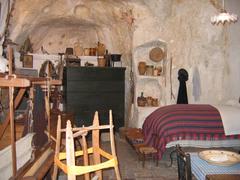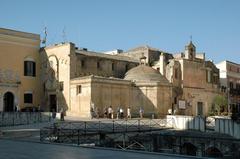Fontana Ferdinandea: Visiting Hours, Tickets, and Historical Insights in Matera, Italy
Date: 14/06/2025
Introduction
Fontana Ferdinandea, elegantly situated in Matera’s Piazza Vittorio Veneto, stands as both a striking architectural centerpiece and a testament to the city’s enduring relationship with water. Commissioned in 1832 during the reign of Ferdinand II of Bourbon, the fountain was designed not only to provide a crucial water source but also to serve as an emblem of civic pride and community resilience. Today, Fontana Ferdinandea continues to captivate visitors with its neoclassical beauty, rich history, and vibrant social role in the heart of Matera. This comprehensive guide offers essential information for planning your visit—including historical context, architectural details, visitor tips, tickets, and accessibility—while inviting you to explore the fountain’s broader significance within Matera’s cultural landscape.
For further details and up-to-date visitor information, consult authoritative resources such as FAI Fondo Ambiente Italiano, Evendo, and MateraWelcome.it.
Historical Background: Origins and Evolution
Fontana Ferdinandea traces its origins to a period of significant urban development in Matera. Constructed in 1832 to replace an earlier 16th-century fountain, the new monument was part of a city-wide effort to address water scarcity and modernize public infrastructure (Just Savour). Its location atop Collina del Castello leveraged natural springs that had sustained the city for centuries, transforming a utilitarian resource into a civic monument. The name “Ferdinandea” honors Ferdinand II of Bourbon, reflecting Matera’s connection to the Kingdom of the Two Sicilies and symbolizing a new era of prosperity.
Over time, the fountain became intertwined with Matera’s identity. It was not only a vital water source but also a gathering place—a site for collecting water, exchanging news, and fostering community bonds. The phrase “Ci vediamo in mezzo alla fontana” (“Let’s meet in the middle of the fountain”) became part of local parlance, underlining the fountain’s social significance (wikimatera.it; oframatera.it).
Fontana Ferdinandea has witnessed many changes, including being dismantled and relocated due to urban modifications and later restored to its original piazza. Its survival and restoration underscore the city’s commitment to preserving its historical and cultural heritage (wikimatera.it; oframatera.it).
Architectural Features and Artistic Details
Fontana Ferdinandea is a quintessential example of neoclassical design, constructed from local limestone. Its harmonious proportions, clean lines, and symmetrical forms are hallmarks of the era. The fountain is adorned with sculptural motifs, including allegorical representations of rivers, and an upper section displaying the city’s coat of arms, surmounted by a royal crown and a Latin inscription commemorating the 1832 restoration (Evendo; Just Savour).
The water flows gracefully into a central basin, creating a tranquil ambiance. The integration of the fountain with its natural surroundings—emerging seamlessly from the hillside—echoes Matera’s broader approach to urban planning, where natural resources are celebrated and incorporated into the built environment.
Social and Cultural Significance
Beyond its utilitarian function, Fontana Ferdinandea has always served as a focal point for community interaction. In the 19th and early 20th centuries, it was the primary source of water for local residents, who would gather with brocche (pitchers) to collect enough for their needs. The fountain’s role as a social anchor persists, as it remains a popular rendezvous for locals and visitors alike (Just Savour).
Its strategic placement in Piazza Vittorio Veneto—one of Matera’s most lively and architecturally rich squares—ensures the fountain is always at the heart of city life. Surrounding cafés, shops, and historic buildings add to its appeal, making it a natural starting point for exploring Matera’s urban landscape.
Water Heritage and Urban Transformation
Matera is renowned for its ancient water management systems, including the Sassi’s network of cisterns and the vast Palombaro Lungo. Fontana Ferdinandea marks a later chapter in this story, representing the shift from private cisterns to communal water access. The arrival of the Acquedotto Pugliese in 1927, which provided the city with a modern aqueduct, ultimately changed the fountain’s function but not its symbolic value. It remains a powerful reminder of Matera’s ingenuity and adaptability in the face of environmental challenges (FAI Fondo Ambiente Italiano).
Practical Visitor Information
Location and Getting There
Fontana Ferdinandea is centrally located in Piazza Vittorio Veneto, easily accessible by foot from all parts of Matera’s historic center. The square is a short walk (approximately 15 minutes) from the main bus station. For those arriving by car, nearby paid parking is available, though spaces can be limited during peak periods (Evendo).
Visiting Hours
The fountain is an open-air monument accessible 24 hours a day, every day of the year. Daylight hours (8:00 AM to 8:00 PM) are recommended for optimal viewing, safety, and photography.
Admission and Tickets
There is no admission fee; visiting Fontana Ferdinandea is completely free. The fountain is not enclosed or ticketed, making it an accessible and spontaneous destination.
Accessibility
The piazza is mostly flat and suitable for visitors with limited mobility, though some surrounding streets have cobblestones and gentle slopes. Wheelchair users will find paved paths and ramps nearby; assistance can be requested at the local visitor center (Earth Trekkers).
Amenities and Nearby Attractions
Piazza Vittorio Veneto is lined with cafés and restaurants serving local specialties such as Pane di Matera and Focaccia di Matera. Public restrooms and benches are available near the fountain.
Notable nearby attractions include:
- Sassi di Matera (UNESCO World Heritage site and ancient cave dwellings)
- Palombaro Lungo (guided tours of the underground cistern)
- Matera Cathedral
- Rock-hewn churches and panoramic viewpoints
The square is an excellent base for exploring Matera’s unique blend of ancient and modern attractions (MateraWelcome.it).
Best Times to Visit and Travel Tips
- Best Time: Early morning or late afternoon for pleasant temperatures and ideal lighting; evenings bring a magical atmosphere with the fountain illuminated and locals gathering.
- Footwear: Comfortable shoes with good grip are recommended due to cobblestone streets (Earth Trekkers).
- Weather: June is particularly pleasant—warm but not overwhelming, and less crowded than mid-summer (MominItaly).
- Dining: Reserve restaurant tables in advance, especially on weekends and during festivals.
Architectural and Artistic Appreciation
The fountain’s neoclassical features and sculptural details make it a favorite subject for photographers and artists. Capture its elegance in the golden morning light or the soft evening glow. Informative plaques around the square provide historical and artistic context, enriching your visit (Evendo).
Special Events and Community Life
Frequently Asked Questions (FAQ)
What are the opening hours of Fontana Ferdinandea?
The fountain is accessible 24/7, but daytime visits (8:00 AM to 8:00 PM) are recommended.
Is there an admission fee?
No, visiting is free of charge.
Is the fountain wheelchair accessible?
The area around the fountain is generally accessible, though some nearby streets have cobblestones.
Are guided tours available?
While no tours focus solely on the fountain, it is a highlight of many walking tours exploring Matera’s historic center.
Can I take photos?
Absolutely—Fontana Ferdinandea is a favorite spot for photography, especially during the golden hour.
What else can I visit nearby?
The Sassi di Matera, Palombaro Lungo, and Matera Cathedral are all within easy walking distance.
Summary and Visitor Tips
Fontana Ferdinandea is much more than an ornate fountain—it is a living monument to Matera’s resilience, communal spirit, and rich water heritage. Its accessible location, historical significance, and integration with everyday city life make it an essential part of any visit to Matera. Whether you are exploring the city’s ancient cave dwellings, relaxing in the piazza, or delving into local history, Fontana Ferdinandea offers a uniquely enriching experience.
To enhance your visit, download the Audiala app for guided tours, maps, and insider tips. For updated information and deeper insights, consult FAI Fondo Ambiente Italiano, Evendo, and MateraWelcome.it.
References and Further Reading
- Visiting Fontana Ferdinandea in Matera: History, Tickets, and Tips, 2025, Fondo Ambiente Italiano (https://fondoambiente.it/luoghi/la-fontana-ferdinandea-e-le-acque-sorgive-della-collina-del-castello?ldc)
- Visiting Fontana Ferdinandea: A Must-See Historical Fountain in Matera’s Piazza Vittorio Veneto, 2024, Evendo (https://evendo.com/locations/italy/matera/attraction/fontana-ferdinandea)
- Visiting Fontana Ferdinandea: History, Hours, Tickets, and Matera’s Cultural Gem, 2024, Wikimatera.it (https://www.wikimatera.it/cosa-vedere-a-matera/i-musei-ed-i-monumenti-di-matera/la-fontana-ferdinandea/)
- Fontana Ferdinandea Visiting Hours, Tickets & Guide to Matera’s Historic Fountain, 2024, Just Savour (https://www.justsavour.com/guida-turistica-matera-fontana-ferdinandea/)


